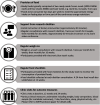The experiences of night shift workers following three different dietary weight loss interventions: a qualitative study using behaviour change theory
- PMID: 40437584
- PMCID: PMC12117937
- DOI: 10.1186/s12966-025-01750-7
The experiences of night shift workers following three different dietary weight loss interventions: a qualitative study using behaviour change theory
Abstract
Background: Shift workers are an estimated 15%-30% of the workforce in developed countries, who are disproportionally at risk of living with overweight or obesity. Dietary guidance is a component recommended for obesity management, however lacks consideration of the lifestyle and circadian disruption experienced by night shift workers. There is a lack of evidence addressing both weight loss and the metabolic consequences of eating at night. Intermittent fasting (IF) may provide metabolic benefits if fasting is aligned with night shifts. The Shifting Weight using Intermittent Fasting in night shift workers study compares three weight-loss interventions: 1) continuous energy restriction (CER); or twice-per-week IF with 2) fasting during night shifts or 3) day fasting. This study aims to explore the experiences of participants while following the interventions to understand how intervention features and external enablers or barriers influence engagement.
Methods: Forty-seven semi-structured interviews (22 baseline, 25 follow-up) were conducted with 33 participants. Eighteen participants also completed optional fortnightly audio diaries to enrich data collected on experiences over time. Interviews and diaries were analysed using the five-steps of framework analysis and themes were deductively mapped to behaviour change frameworks and the social-ecological model.
Results: Analysis resulted in seven major themes and 27 subthemes. Three main themes describe intervention factors influencing engagement: 1) Simplicity and ease, 2) Support and accountability, and 3) An individualised approach is sometimes needed. Four themes described external factors to the interventions influencing engagement: 4) Personal motivation and attitudes, 5) Physiological influences of eating behaviours, 6) Social support at home and work, and 7) Work structure and environment.
Conclusions: Across all three interventions, participants valued the ease of interventions, which was the clear dietary prescription and focus on two days per week for IF, or a focus on small changes for CER. Behavioural regulation and providing meals/snacks were identified as critical features. Modifications to address identified enablers/barriers include: providing flexible fasting periods; addition of fatigue management initiatives; increased focus on non-weight related health changes during periods of slowed weight-loss; implementation in workplace settings to harness social support; and providing a healthier food environment.
Keywords: Diet; Intermittent fasting; Nutrition; Obesity; Overweight; Qualitative study; Shift work; Work schedule.
© 2025. The Author(s).
Conflict of interest statement
Declarations. Ethics approval and consent to participate: This study was approved by Monash Health (HREC ref: RES 19–0000- 462A) and the University of South Australia (HREC ID: 202379) Human Research Ethics Committees and Ambulance Victoria Research Committee (R19-037). Written consent was obtained from all participants. Consent for publication: The consent form was signed on the understanding that de-identified data from the study would be used in publications. Competing interests: The authors declare no competing interests.
Figures
Similar articles
-
Evaluation of the "Shifting Weight using Intermittent Fasting in night-shift workers" weight loss interventions: a mixed-methods protocol.Front Public Health. 2023 Sep 7;11:1228628. doi: 10.3389/fpubh.2023.1228628. eCollection 2023. Front Public Health. 2023. PMID: 37744523 Free PMC article.
-
Intermittent fasting interventions for the treatment of overweight and obesity in adults aged 18 years and over: a systematic review protocol.JBI Database System Rev Implement Rep. 2015 Oct;13(10):60-8. doi: 10.11124/jbisrir-2015-2363. JBI Database System Rev Implement Rep. 2015. PMID: 26571283
-
Exploring Australian night shift workers' food experiences within and outside of the workplace: a qualitative photovoice study.Public Health Nutr. 2023 Nov;26(11):2276-2287. doi: 10.1017/S1368980023001519. Epub 2023 Aug 7. Public Health Nutr. 2023. PMID: 37548181 Free PMC article.
-
Intermittent fasting interventions for treatment of overweight and obesity in adults: a systematic review and meta-analysis.JBI Database System Rev Implement Rep. 2018 Feb;16(2):507-547. doi: 10.11124/JBISRIR-2016-003248. JBI Database System Rev Implement Rep. 2018. PMID: 29419624
-
Fasting for weight loss: an effective strategy or latest dieting trend?Int J Obes (Lond). 2015 May;39(5):727-33. doi: 10.1038/ijo.2014.214. Epub 2014 Dec 26. Int J Obes (Lond). 2015. PMID: 25540982 Review.
References
-
- International Agency for Research on Cancer (IARC). IARC monographs on the identification of carcinogenic hazards to humans - night shift work. Geneva, Switzerland: World Health Organization; 2020.
-
- Sun M, Feng W, Wang F, Li P, Li Z, Li M, et al. Meta-analysis on shift work and risks of specific obesity types. Obes Rev. 2018;19(1):28–40. - PubMed
-
- Gan Y, Yang C, Tong X, Sun H, Cong Y, Yin X, et al. Shift work and diabetes mellitus: a meta-analysis of observational studies. Occup Environ Med. 2015;72(1):72–8. - PubMed
-
- Bøggild H, Knutsson A. Shift work, risk factors and cardiovascular disease. Scand J Work Environ Health. 1999:85–99. - PubMed
-
- Kecklund G, Axelsson J. Health consequences of shift work and insufficient sleep. BMJ. 2016;355. - PubMed
MeSH terms
Grants and funding
LinkOut - more resources
Full Text Sources
Medical
Miscellaneous


